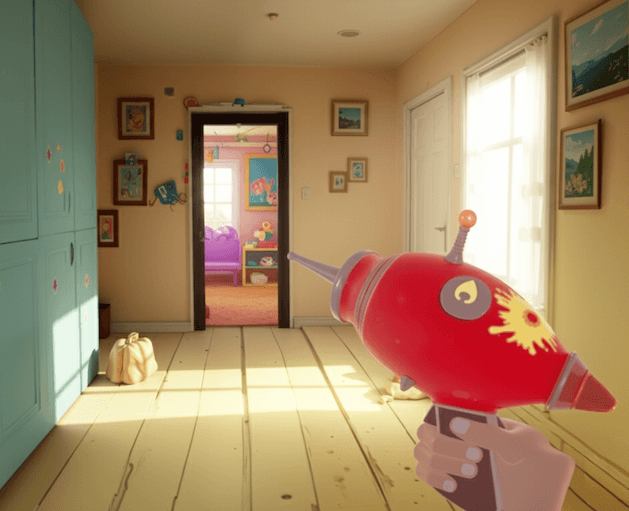Sep 16, 2025How Escape.ai and Marble use AI and spatial generation to turn cinematic worlds inside out — letting audiences step into films and watch them unfold from within.
Turning 2D Cinema into 3D Worlds: Escape.ai x Marble
Collaboration Overview
Escape.ai is a next-generation platform for interactive cinema and AI-driven entertainment. It curates, aggregates, and distributes experimental storytelling experiences while supporting the creators behind them.
In collaboration with Marble, Escape.ai explored how spatial reconstruction could expand the boundaries of film. The goal was to turn 2D cinematic content into explorable 3D worlds — and at the same time, let audiences watch those same films from inside their generated environments.
This early experiment connected Marble’s world-generation API with Escape.ai’s Creator Studio, enabling a workflow where filmmakers could automatically generate both a 3D environment and a viewing space.
The result is a hybrid experience: cinema that exists on screen and around you.
The Project
The prototype demonstrated a working integration between Escape.ai’s Video Intelligence AI and Marble’s spatial engine.
When a creator uploads a film, Escape’s system automatically extracts key visual frames and sends them to Marble’s API. Within minutes, Marble returns a set of Gaussian Splats that form the basis of a 3D reconstruction.
These reconstructions power two simultaneous experiences:
- An explorable 3D environment inspired by the film’s imagery — allowing users to walk through its world.
- A cinematic theater inside that environment, where the film itself can be watched on a 2D screen embedded in the space.
The effect is immersive and recursive: viewers can move freely through a world that’s visually and emotionally tied to the film they’re watching.
The prototypes — developed with multimedia artists Francesca Fini, Kavan the Kid, and Videostate — demonstrated how this new form of spatial cinema could feel both familiar and completely new.
Creative & Technical Process
Escape.ai’s development team built a seamless pipeline connecting film analysis, spatial reconstruction, and real-time rendering.
- Video Processing: Escape’s Video Intelligence AI analyzes uploaded films, identifies key frames, and prepares them for 3D conversion.
- 3D Reconstruction: Marble’s API processes these frames to create Gaussian Splats, producing detailed 3D geometry with cinematic lighting and depth.
- Environment Generation: The generated splats are imported into PlayCanvas, where Escape’s multiplayer template adds rendering, spatial audio, and social interactivity.
- Integrated Viewing: A 2D film display is embedded within the generated 3D space, allowing viewers to watch the original movie while exploring its reconstructed world.
- Collaboration & Iteration: The Escape.ai and Marble Labs teams worked with Francesca Fini to tune reconstruction quality and optimize visual consistency between the film and its 3D environment.
This system effectively turns any cinematic work into both a film and a place — merging storytelling and spatial computing into one seamless experience.
Results & Impact
The collaboration demonstrated a new form of media experience — one that bridges traditional cinema and interactive worldbuilding.
For filmmakers: It lowers the barrier to creating immersive, explorable companion spaces for their films.
For audiences: It introduces a new way to engage with cinema — not just by watching, but by stepping inside it.
For developers: It proved that Marble’s API and Gaussian Splats pipeline can power scalable integrations inside other creative platforms.
Key outcomes included:
- Rapid 3D world generation from standard 2D video input.
- A hybrid viewing experience where film and environment coexist.
- A working prototype of a multiplayer “cinematic world” built entirely with AI-driven tools.
Looking Ahead
Escape.ai and Marble plan to continue refining the integration, focusing on larger and more complex cinematic environments.
Future experiments include:
- Generating interactive characters and set pieces from film data.
- Extending lighting and particle effects for higher realism.
- Scaling the API to handle full-length films and persistent shared worlds.
This early prototype shows the incredible potential between Escape.ai and Marble Labs. The Marble API gives us a fast, efficient way to generate 3D environments from film content — empowering creators to bring their stories to life in entirely new ways.
Kris Michael, Chief Product Officer at Escape.ai
Read More
Sep 16, 2025
Gaussian Mansion: Creating Playable Worlds with Marble
Integrating spatial generation, AI-driven modeling, and Unreal Engine to streamline 3D world production from concept art to gameplay.

Sep 16, 2025
Splat World: Exploring New Dimensions of Gaussian Splatting in VR
How one developer turned Gaussian splats into a new language for building interactive worlds.
